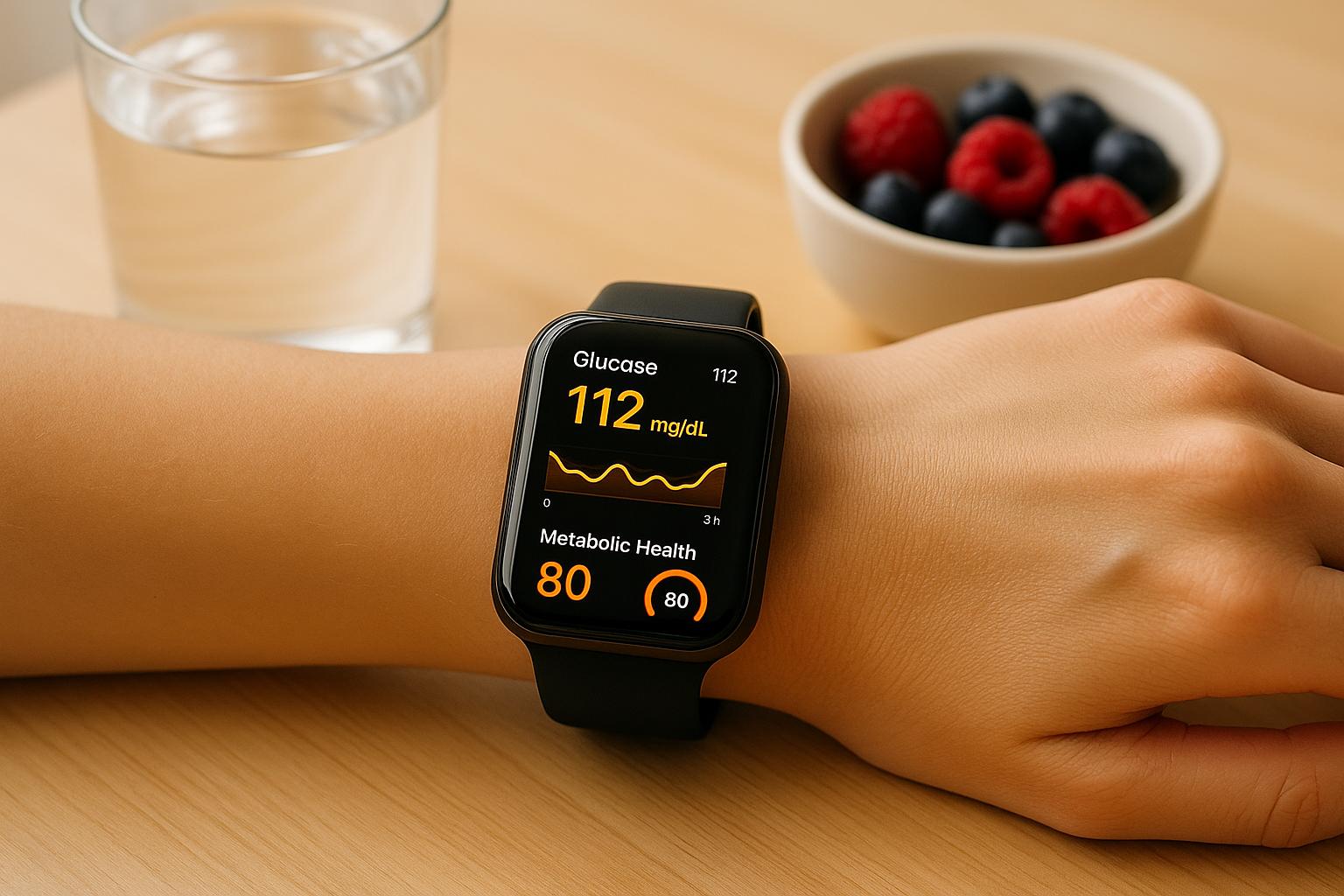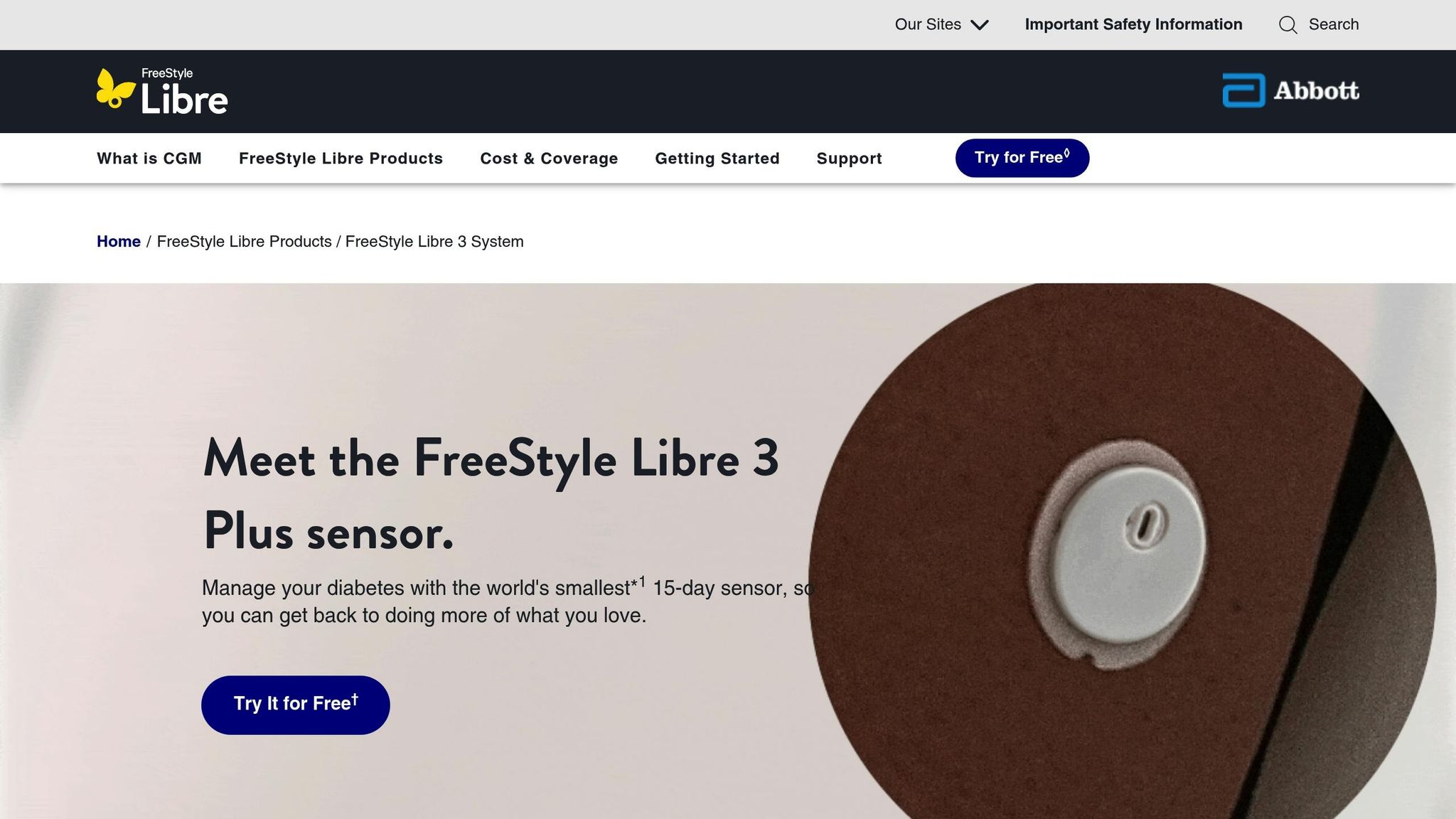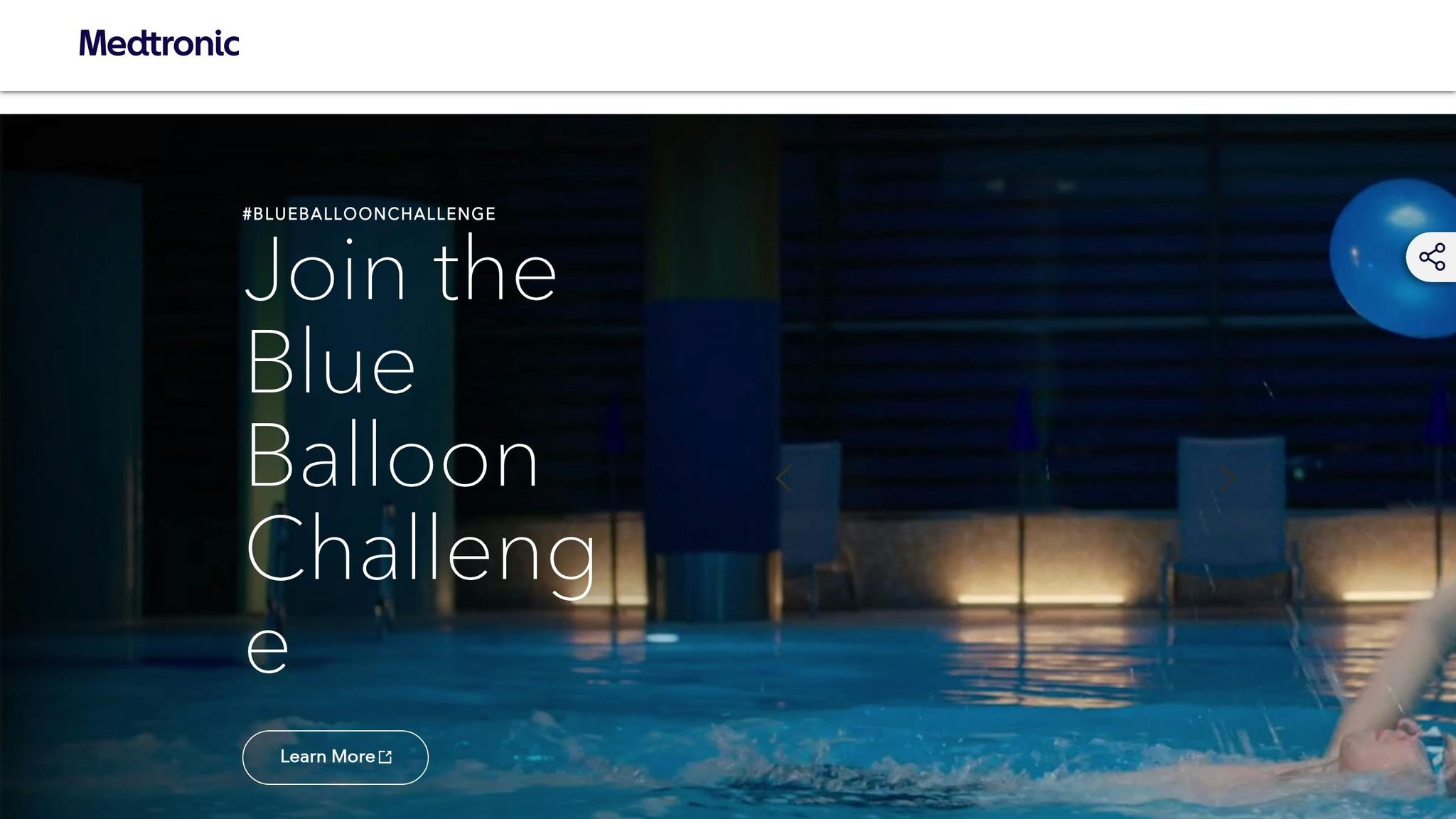
Managing insulin resistance has never been easier, thanks to advanced wearable devices in 2025. These tools, like the Dexcom G7 and Abbott FreeStyle Libre 3, offer real-time glucose monitoring, helping you track how food, exercise, sleep, and stress impact your blood sugar. With features like smartphone integration, predictive alerts, and extended wear durations, they provide actionable insights to improve your metabolic health.
Key Features to Look For:
- Real-Time Glucose Monitoring (CGM): Continuous data without finger pricks.
- Data Integration: Easy-to-use apps for tracking trends and sharing with doctors.
- Additional Metrics: Sleep, heart rate, and stress tracking for a holistic view.
- Comfort & Accuracy: Slim designs, reliable readings, and long wear times.
Top Devices for 2025:
- Dexcom G7: Compact, 30-min warm-up, 15.5-day wear, 8.2% accuracy.
- Abbott FreeStyle Libre 3: 1-min updates, 14-15 day wear, discreet design.
- Medtronic Guardian 4: Predictive alerts, insulin pump integration.
- Nutrisense & Levels Health: Subscription-based CGM insights (non-FDA reviewed).
| Device | Monitoring Frequency | Accuracy (MARD) | Wear Duration | Warm-Up Time | FDA-Cleared | Cost |
|---|---|---|---|---|---|---|
| Dexcom G7 | Every 5 minutes | 8.2% | 10.5-15.5 days | 30 minutes | Yes | Insurance-covered |
| Abbott FreeStyle 3 | Every minute | 8.9% | 14-15 days | 60 minutes | Yes | Insurance-covered |
| Medtronic Guardian 4 | Not specified | Not stated | 7 days | Not stated | Yes | Insurance-covered |
| Nutrisense & Levels | Real-time | Not FDA-reviewed | 14 days | Not stated | No | Subscription-based |
Wearables empower you to take control of insulin resistance. Choose the right device for your needs, consult your healthcare provider, and start making data-driven lifestyle changes today.
S2 Episode 4: Tech Geek: The Latest in Type 2 Diabetes Wearables and Devices
What to Look for in Insulin Resistance Wearables
Finding the right wearable for managing insulin resistance means focusing on features that truly make a difference. While there are plenty of options out there, certain capabilities stand out as essential for effective tracking of metabolic health.
Real-Time Continuous Glucose Monitoring (CGM)
At the heart of managing insulin resistance today is continuous glucose monitoring (CGM). Unlike traditional finger-prick tests, CGM provides constant glucose readings, removing the guesswork from monitoring.
This technology uses a tiny sensor placed under the skin to measure interstitial glucose levels. Many devices are designed for extended wear, meaning fewer sensor replacements and more consistent data collection.
For those managing insulin resistance, CGM offers a deeper understanding of glucose trends that traditional methods might miss. It shows how your body reacts to meals, stress, sleep, and exercise. Plus, predictive alerts can warn you about upcoming glucose changes, giving you the chance to adjust in real time.
Data Integration and Analytics
A wearable is only as good as the insights it provides. Devices with seamless smartphone integration make it easy to turn raw glucose data into actionable insights. By combining multiple data points into one user-friendly interface, you can better understand how your lifestyle choices affect your glucose levels.
Modern CGM systems sync wirelessly with apps that offer detailed dashboards, showing trends over days, weeks, or even months. Many of these apps also allow you to share your data with healthcare providers, enabling them to review your patterns remotely and tailor treatment plans to your needs.
Tracking Additional Health Metrics
Effective metabolic health monitoring goes beyond just glucose levels. Insulin resistance can affect multiple systems in your body, contributing to problems like high blood pressure and inflammation. Wearables that track additional metrics provide a more complete picture of your health.
Sleep tracking is especially important, as poor sleep can significantly reduce insulin sensitivity. Devices that monitor sleep quality - including duration, stages, and disturbances - offer valuable insights into how rest impacts your glucose levels. Similarly, tracking heart rate and physical activity, such as steps and exercise intensity, is crucial since regular exercise is one of the best ways to manage insulin resistance. Some advanced wearables are even adding features like heart rate variability and cortisol level tracking, which can shed light on how stress affects glucose metabolism.
Comfort and Ease of Use
For any wearable to be effective long-term, comfort is key. Managing insulin resistance often requires using these devices consistently over months or even years, so choosing one that feels good to wear is critical.
Look for devices with slim, flexible designs and skin-friendly adhesives that stay secure during workouts or showers without irritating your skin. Beyond physical comfort, the usability of the companion app matters just as much. The best apps simplify complex data with intuitive interfaces and customizable alerts for personalized glucose warnings.
Accuracy is another must-have. Devices like the Dexcom G7 and FreeStyle Libre are known for delivering reliable readings, giving you the confidence to make informed decisions about your lifestyle. Calibration-free systems are also a big plus, as they make monitoring easier and more convenient for everyday use.
Best Wearable Devices for Insulin Resistance Management in 2025
The landscape of devices designed for insulin resistance management has made incredible strides, offering more precise monitoring and better user experiences. Here’s a look at some of the top wearable devices making a difference in 2025.
Dexcom G7

The Dexcom G7 stands out with its compact design and advanced monitoring capabilities. At 60% smaller than the previous G6 model, it provides a discreet and comfortable experience for users. One of its key features is a quick 30-minute warm-up time - much faster than the one-hour warm-up required by many other CGMs. The device boasts exceptional accuracy, with a Mean Absolute Relative Difference (MARD) of 8.2%. For those needing extended wear, the FDA-approved Dexcom G7 15-Day version offers an industry-leading MARD of 8.0%, with a wear time of up to 15.5 days, including a 12-hour grace period - 50% longer than the standard G7’s 10.5-day duration.
"96% of people on Dexcom G7 say it's easy to use", according to company data.
The Dexcom G7 pairs seamlessly with smartphones, providing real-time alerts and predictive technology to warn users of potential glucose changes. Approved for individuals as young as 2 years old, it’s a versatile choice for families managing diabetes.
Next up, the Abbott FreeStyle Libre 3 offers a highly discreet alternative for continuous monitoring.
Abbott FreeStyle Libre 3

The FreeStyle Libre 3 delivers real-time glucose readings every minute - no finger sticks required. Its compact and discreet design makes it an appealing option for those who prefer a less noticeable device. The standard sensor offers a 14-day wear period, while the FreeStyle Libre 3 Plus extends that to 15 days.
One of its standout features is automatic data transmission to your smartphone, eliminating the need for manual scans. This allows users to effortlessly track how their glucose levels respond to meals, exercise, and stress throughout the day.
For those looking for more advanced features like automated insulin management, the Medtronic Guardian 4 is worth considering.
Medtronic Guardian 4

The Medtronic Guardian 4 excels in predictive technology and seamless insulin pump integration. This device actively supports glucose management by predicting fluctuations and automatically adjusting insulin delivery to prevent dangerous highs or lows.
"CGM data provides actionable insight to help patients track their glycemic response to dietary choices and activity levels", says Dr. Josh Emdur, Medical Director of SteadyMD.
The Guardian 4 also integrates with Medtronic’s smart dosing devices, easing the mental load of constant glucose monitoring and manual insulin adjustments. This system is ideal for users seeking a more automated and hands-off approach to insulin resistance management.
sbb-itb-cad6158
Device Comparison
When choosing the right insulin resistance wearable, it’s essential to weigh key factors like accuracy, convenience, and cost. The table below highlights the main specifications of popular devices.
| Device | Monitoring Technology | Reading Frequency | Accuracy (MARD) | Warm-up Time | Wear Duration | FDA Clearance | Estimated Cost |
|---|---|---|---|---|---|---|---|
| Dexcom G7 | Real-time CGM | Every 5 minutes | 8.2% | 30 minutes | 10.5 days (15.5 days for 15‑Day version) | Yes | Typically covered by insurance |
| Abbott FreeStyle Libre 3 | Real-time CGM | Every minute | 8.9% | 60 minutes | 14 days (15 days for Plus version) | Yes | Typically covered by insurance |
| Medtronic Guardian 4 | Real-time CGM with predictive alerts | Not specified | – | – | 7 days | Yes | Typically covered by insurance |
| Nutrisense CGM | Continuous glucose monitoring | Real-time | Not FDA‑reviewed | – | 14 days | No | Subscription‑based pricing |
| Levels Health | CGM‑based insights | Real-time | Not FDA‑reviewed | – | 14 days | No | Subscription‑based pricing |
| Biolinq | Continuous monitoring | Not specified | Not available | Not available | Not specified | Pending | Not available yet |
Key Insights
- Accuracy and Frequency: Among FDA-cleared devices, the Dexcom G7 leads with an 8.2% MARD, slightly ahead of the Abbott FreeStyle Libre 3 at 8.9%. Additionally, the FreeStyle Libre 3 updates glucose readings every minute, providing faster feedback compared to the Dexcom G7's five-minute intervals.
- Warm-up and Wear Time: The Dexcom G7 has a shorter warm-up period of just 30 minutes, compared to the FreeStyle Libre 3's 60 minutes, which means quicker access to data. For extended wear, the Dexcom G7's 15-Day version offers up to 15.5 days of use, a longer duration than most other devices.
- Insurance Coverage: FDA-cleared devices like the Dexcom G7, FreeStyle Libre 3, and Medtronic Guardian 4 are typically covered by insurance, making them more affordable for many users. On the other hand, consumer-focused platforms such as Nutrisense and Levels Health require direct payment through subscription plans, as these devices lack FDA validation.
- Special Features: The Medtronic Guardian 4 stands out for its integration with automated insulin pumps and predictive glucose alerts, offering advanced management options for users.
- Accessibility vs. Validation: Consumer platforms like Nutrisense and Levels Health provide easy access without requiring a prescription. However, this convenience comes at the cost of clinical validation, as these devices are not FDA-reviewed.
How Wearable Data Helps Manage Insulin Resistance
Wearable devices are transforming how we manage insulin resistance, offering continuous insights without the need for constant finger pricks. Unlike traditional blood sugar testing, these devices provide a steady flow of data, showing how your body reacts to daily activities, meals, and lifestyle choices. Let’s dive into how these real-time insights enable targeted lifestyle changes.
Real-Time Dietary and Lifestyle Insights
Continuous glucose monitoring (CGM) delivers instant feedback on metabolic trends. According to MindStream Integrative Medicine, "Continuous glucose monitoring (CGM) offers a powerful way to understand and improve your metabolic health in real-time". This feedback helps pinpoint dietary triggers, making it easier to adjust carbohydrate intake and meal timing to stabilize blood sugar levels.
These devices also shed light on how different physical activities impact glucose control and insulin sensitivity. For example, you can fine-tune your pre-workout meals or snacks to maintain energy during exercise. Additionally, data on sleep and stress patterns can guide lifestyle changes when these factors negatively influence glucose levels.
Partnering with Healthcare Providers for Better Outcomes
Sharing wearable data with healthcare providers creates opportunities for personalized care. In fact, research shows that 46.3% of wearable device users share their data with healthcare professionals, with individuals managing diabetes being 66% more likely to do so. This real-time data allows providers to track patterns and make timely adjustments to treatment plans. Devices like CGMs can help refine medication doses and schedules, while easy data sharing supports remote monitoring and virtual consultations, improving the overall efficiency of care. This collaboration enhances early detection and enables tailored interventions.
Early Detection for Better Metabolic Management
Wearables play a critical role in catching blood sugar issues early. Real-time monitoring can quickly identify episodes of hypo- or hyperglycemia, allowing for immediate action. Studies have found that continuous monitoring often leads to greater reductions in HbA1c levels compared to traditional testing, especially for individuals starting with an HbA1c above 8.0%.
Tailored Intervention Strategies
The data from wearables enables highly personalized approaches to managing insulin resistance. CGMs provide continuous feedback, helping you optimize your nutrient intake and meal timing based on your unique glucose responses. Over time, the patterns revealed by this data can guide tailored plans for nutrition and meal scheduling. As highlighted by MetforminDaily, these insights empower individuals to make informed decisions about their metabolic health, leading to better outcomes through real-time, personalized strategies.
Conclusion
Wearable technology for managing insulin resistance has reached new heights in accuracy and ease of use by 2025. Devices like the Dexcom G7, known for its improved precision, and Abbott's FreeStyle Libre 3, with its real-time monitoring capabilities, are reshaping how millions of Americans track their metabolic health.
As of March 2023, about 2.4 million people in the U.S. are using continuous glucose monitors (CGMs). Additionally, 83.9% of individuals with diabetes find wearable devices helpful for tracking glucose levels and physical activity. Even more promising, 81.9% of people with diabetes are open to adopting AI-powered wearables if recommended by their healthcare provider.
AI-based systems have made significant strides, adapting to changes in the body and offering more precise guidance for insulin dosing. This progress marks a shift from reactive to proactive diabetes management, with the potential to incorporate additional health indicators like heart rate variability and cortisol levels. These advancements pave the way for more informed and personalized care.
When choosing a device, think about how it aligns with your lifestyle and health needs. Consider factors like how often you'll need to scan, connectivity options, insurance coverage, and how seamlessly the device fits into your daily routine. Dr. Rebecca Fenichel from Westmed Medical Group highlights the value of CGMs:
"Continuous glucose monitors offer more intensive monitoring of a diabetic patient's sugar levels...They are particularly well suited to patients who have to check multiple times a day or to patients who want to get more frequent feedback during the day."
However, successful management of insulin resistance goes beyond just having the right device. It requires proper education, ongoing support, and a lifestyle that complements these tools. Always consult your healthcare provider to identify the best options for your specific health goals.
Staying informed is essential as technology continues to evolve. For those looking to keep up with the latest in metabolic health and wearable technology, MetforminDaily offers reliable, science-backed insights and expert advice. Our platform keeps you updated on advancements in insulin resistance management, helping you make well-informed choices to support your health journey with practical, evidence-based solutions.
FAQs
What should I look for in a wearable device to help manage insulin resistance?
When picking a wearable device to help manage insulin resistance, continuous glucose monitors (CGMs) are a top choice. These devices track your blood sugar levels in real time, offering 24/7 monitoring. They can alert you to highs and lows and show trends, making it easier to make well-informed health decisions.
Pay attention to comfort, since you'll be wearing the device for long periods, and check its compatibility with your smartphone or smartwatch for seamless data access. By 2025, wearable tech is set to take a leap forward with fitness trackers and smartwatches featuring built-in glucose monitoring. These tools provide a more discreet and convenient way to stay on top of your health.
Focusing on these features can help you find a device that matches your lifestyle and supports better insulin resistance management.
What makes continuous glucose monitors (CGMs) better than finger-prick tests for managing insulin resistance?
Continuous glucose monitors (CGMs) provide real-time insights into your glucose levels, creating a detailed view of how your blood sugar fluctuates throughout the day and night. Unlike traditional finger-prick tests that offer a single snapshot, CGMs uncover patterns and shifts, helping you see how meals, physical activity, and even stress influence your glucose levels.
These devices can also play a key role in managing insulin resistance. By offering tailored insights, CGMs help you pinpoint which lifestyle changes - like adjusting your diet or improving your sleep - could enhance your insulin sensitivity and overall health. With continuous updates, they enable you to take a hands-on, informed approach to maintaining better metabolic health.
Can wearables for insulin resistance management connect with other health apps or devices?
Yes, many wearable devices aimed at managing insulin resistance now work seamlessly with other health apps and devices. By 2025, technology has advanced to the point where devices like continuous glucose monitors (CGMs) and insulin pumps can easily sync with health tracking apps. This means users can track not only their glucose levels but also vital signs such as heart rate, blood pressure, and oxygen saturation - all in one place.
This kind of integration offers a more comprehensive view of your health, making it simpler to tailor your insulin management and daily habits. With data coming from multiple sources, these wearables give users the tools they need to make smarter, more informed choices to support their overall well-being.
.png)



